![]() 1st Battalion 22nd Infantry
1st Battalion 22nd Infantry ![]()
Frank B. Jones
22 Years Service with the 22nd Infantry
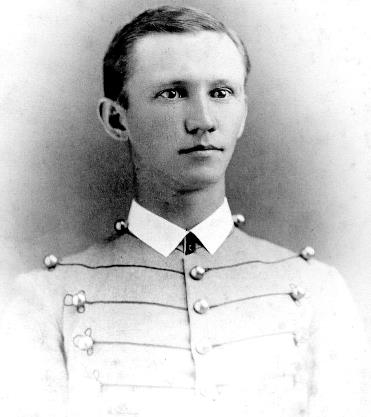
Frank B. Jones in his graduation
portrait from
the US Military Academy at West Point
Webmaster's collection
Frank Beall Jones entered the
United States Military Academy at West Point from the State of
Mississippi
on July 1, 1875 and graduated 59 out of a class of 66 on June 13,
1879. His best subjects were Drawing
and Mathematics and his worst subjects were Law and Chemistry.
Upon graduation he was commissioned
a Second Lieutenant in the 22nd Infantry. Of note, one other
graduating cadet was assigned to the 22nd Infantry that year,
Augustine Hewit, who served in Company E 22nd Infantry from 1879
until his death by fever in 1882. In the same graduating class
that year were two other cadets, who, though not initially
assigned to the 22nd Infantry, would both later command the
Regiment.
Charles A. Noyes would command the 22nd Infantry from April 25,
1914 to July 7, 1914. Charles M. Truitt would command
the 22nd Infantry from July 7, 1914 to February 27, 1916.
Assigned to Company K, Jones served with the 22nd Infantry on
frontier duty at Fort Gibson, Indian Territory,
from September 30 to October 4, 1879. He took part in the Ute
Expedition of the Regiment from Oct 1879 through
January 23, 1880, after which he was stationed at San Antonio,
Texas until February 1880. From February of 1880
until November 16, 1882 he served with Company K at Fort Clark,
Texas. In late 1882 he moved with Company K
to Fort Lewis, Colorado. Jones was on detached duty in connection
with the Bureau of Indian Affairs at Fort Apache,
Arizona, from December 6, 1885 to October 28, 1886, after which
he rejoined his Company at Fort Lewis.
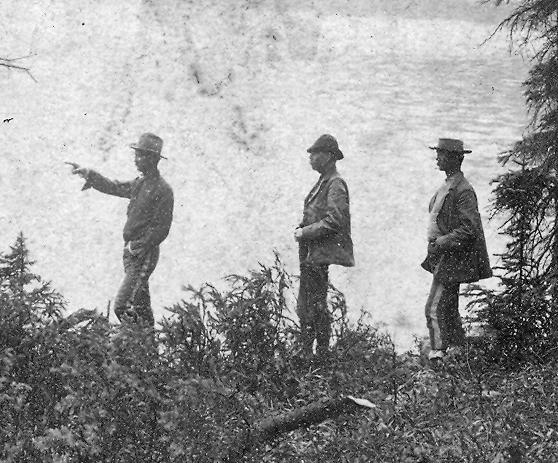
Three officers of the
22nd Infantry at Lone Lake, summit of Needles Mountain, Colorado
ca. 1885.
Left to right: 1st Lieutenant William H. Kell, Captain Charles W.
Miner, 2nd Lieutenant Frank B. Jones.
Photo taken by Christian
Barthelmess of the 22nd Infantry
From the book Photographer On An Army Mule
by Maurice Frink with Casey E. Barthelmess
University of Oklahoma Press
Jones was part of 1st Lieutenant
E.W. Casey's expedition to the Grand Canyon during the months of
November 1887
to January 1888.
He was promoted to First
Lieutenant on January 1, 1888, and on February 14 of that year he
and Company K were then
stationed at Fort Lyon, Colorado. On June 1, 1888 he moved with
the Regiment to Fort Keogh, Montana. He was
the Regimental Adjutant of the 22nd Infantry at Keogh from
January 16, 1892 to January 16, 1896.
On January 5, 1896 Jones went on
leave, and while on leave he was promoted to Captain on May 1,
1896.
With his leave up on June 5, 1896, he was given command of
Company E and went with the Regiment to Fort Crook,
Nebraska. He commanded the Company on garrison duty at Fort Crook
until April 18, 1898, when the entire Regiment
left for Tampa, Florida, to prepare for deployment to Cuba.
|
22nd Infantry General Orders No. 100, 1892 Directing two officers from
other units, who had Also directs a board of survey
to be formed, Signed by 1st Lieutenant Frank
B. Jones |
In June 1898 Jones brought
Company E ashore in Cuba, during the Spanish-American War, and
led the Company
at the Battle of El Caney, where, on July 1, he was wounded in
action sufficiently to have to relinquish command
of the Company to 1st Lieutenant Orrin Wolfe. He then went on
sick leave in order to recover from his wounds, until
September 10, when he resumed command of Company E and went with
them and the Regiment to Fort Crook.
Jones brought Company E to the
Philippines in early March, 1899. On March 18, 1899, while
commanding a battalion
of the 22nd Infantry consisting of Companies D, E, G and M, he
was wounded in an engagement near Taugig, during
the Pasig Expedition. Their ranks depleted by sickness and
disease, those four Companies together could only muster
approximately 200 men. Outnumbered four to one, they fought a
battle with 800 insurgents that lasted nearly four hours.
Besides Jones, the 22nd Infantry suffered fifteen other wounded
and three killed during that fight.
Frank B. Jones was awarded a
Silver Star Citation for his actions that day, entitling him to
wear a silver star on his
Philippine Campaign Medal. In 1932 the Secretary of War
authorized the Silver Star Medal to replace
the Silver Star Citation.

Frank B. Jones'
decorations
His Philippine Campaign Medal has a silver star to denote award
of the Silver Star Citation.
In 1932 The War Department authorized the replacement of the
Silver Star Citation by the
Silver Star Medal.
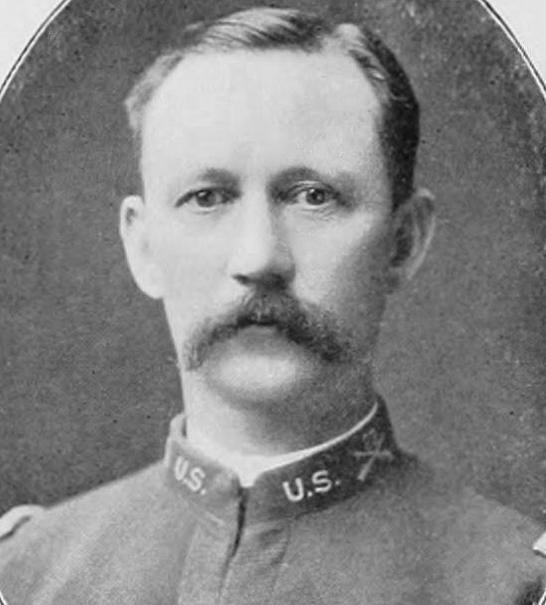
Frank B. Jones as a Captain in the 22nd
Infantry. Note collar insignia
of crossed rifles with 22 above denoting 22nd Infantry.
Photo from From "A military album,
containing over one thousand portraits of commissioned officers
who served
in the Spanish-American war" L.R. Hamersly 1902.
Jones remained in a hospital in
the Philippines, recovering from his wounds until May 1899. He
was apparently
on light duty until October of that year, as Company E was
commanded in turn by several junior officers
during that time. On October 1, 1899 Jones was again in command
of Company E, as part of 1st Battalion
22nd Infantry, under Major John G. Ballance. From October 1 to
October 4 the Battalion was committed in an attack on
the towns of Matamo and Arayat, in northern Luzon. Jones and
Company E were the lead element in both attacks,
and Ballance credits Jones and his Company with single-handedly
driving the enemy from the main defensive
trenches leading to Arayat. In his after action report Ballance
also then credited Jones and Company E,
along with Company F, as forcing the last of the defenders out of
Arayat, and securing the town.
At the end of November, Jones
left the Regiment and returned to the United States on December
28, 1899.
After a short leave, he was assigned to recruiting duty at Macon,
Georgia, on January 10, 1900.
On July 20, 1901 Jones was
transferred to the 17th Infantry, ending 22 years of service with
the 22nd Infantry.
On July 26, 1901 he was promoted to Major of the 9th Infantry. He
ended his recruiting duty on May 14, 1902,
and the next day, on May 15, he joined the 9th Infantry Regiment
at Madison Barracks, New York. The 9th Infantry
Regimental roster for July 1, 1904 shows Jones in Command of 3rd
Battalion and of the camp at the rifle range
at Madison Barracks for that year.
On August 26, 1904, he changed
duty stations to Manassas, Virginia, and commanded the 3rd
Battalion 9th Infantry there,
from August 27 to September 16. From that date, in addition to
his command of 3rd Battalion, he became an inspector
of militia units, until May 1, 1905. He then went with the 9th
Infantry to the Philippines, and from June 8, 1905 to
September 1, 1907 he commanded 3rd Battalion on duty in the
Philippines at Camp Daraga. He then returned to the
United States, where he was on a leave of absence until November
3, 1907.
On October 4, 1907, Jones was
promoted to Lieutenant Colonel of the 19th Infantry. From
November 3 to November 27, 1907
he was on detached service at Fort Sam Houston, Texas. He was
with the 19th Infantry at Fort Bliss, Texas, until June 15, 1908,
when he went with the Regiment on manuvers at Leon Springs, Texas
until July 30. From that time he was assigned to Fort Bliss
until November 11, 1908. On October 28, 1908 he was detailed as
the Adjutant-General, Department of the Gulf, a duty which he
began on November 14 of that year. From June 27 to July 31, 1910
he was at the Manuever Camp at Chickamauga Park, Georgia.
Jones was then stationed at Atlanta, Georgia, from August 1, 1910
to June 20, 1911, at which time he was relieved from the detail
to the Adjutant-General's Department.
On June 21, 1911, Frank B. Jones
was promoted to Colonel and given command of the 15th Infantry.
He was on
a leave of absence and enroute to Fort Douglas, Utah, from June
21 to August 20, 1911. He was at Fort Douglas
commanding the 15th Infantry from August 21 to September 12,
1911, when he became ill, and went on sick leave
from September 13 to November 13. On November 15 he was admitted
to the Army and Navy General Hospital
at Hot Springs, Arkansas, where he remained until February 12,
1912. He then was at Fort Douglas on temporary
duty from February 20 to March 1. He was enroute to take command
of the 15th Infantry at Tientsin from March 2
to April 25. He officially commanded the 15th Infantry Regiment
in China from April 25, 1912 to July 1, 1913.
On July 1, 1913 Jones was
transferred to the 8th Infantry. He was at Nagasaki, Japan, from
August 4 to October 1, 1913,
enroute to, and awaiting transportation to the Philippines. He
arrived in the Philippines on October 7, and was at Camp
Keithley,
on the island of Mindanao, from October 7 to November 1. On
November 7, 1913 he assumed command of the
8th Infantry Regiment at Manila, island of Luzon, where he
remained until February 15, 1915.
On February 1, 1915 he became
unassigned, and nine days later was assigned to the 7th Infantry.
Jones left the Philippines on
February 15, and was enroute to the United States and on a leave
of absence until May 1, 1915. He was at Galveston, Texas,
with the 5th Brigade of the 2nd Division from May 2 to September
22, 1915. He assumed command of the 7th Infantry
at El Paso, Texas on September 25 and remained there until
October 29. He commanded the Regiment at Douglas, Arizona,
from October 30 to November 26, at Nogales, Arizona, from
November 27 to December 11, and at Fort Bliss, Texas,
from December 12-27. From December 29, 1915 to April 4, 1916,
Jones attended the Field Officers Course at the Army
Service School at Fort Leavenworth, Kansas. He returned to Fort
Bliss to command the 7th Infantry on April 6, and remained
there with the Regiment until May 27, 1917. From May 29 to
November 2, 1917, he commanded an assembly of U.S. troops at
Gettysburg National Park. He then moved with the 7th Infantry to
Camp Greene, North Carolina, where he commanded the
Regiment from November 4, 1917 to January 31, 1918.
On February 1, 1918, at his own request, he was retired from the US Army, with nearly 43 total years of service.
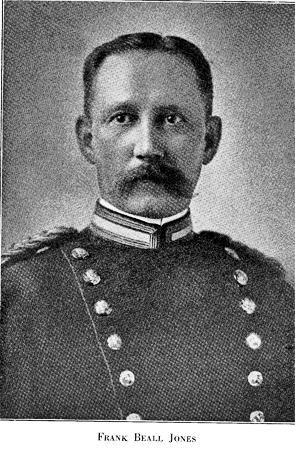
FRANK BEALL JONES
No. 2818 CLASS OF 1879
Died August 10, 1929, at Coronado, California, aged 73 years.
COLONEL FRANK BEALL JONES was born January 1, 1856 at Hernando, Mississippi.
During his long and honorable
service on the active list he was known among his friends of the
old Army as a "duty officer",
as distinguished from the detached service class, he having
served thirty of his thirty-nine years of active commissioned
service
on regimental duty.
His early service was with the
22nd Infantry in the field in Southwestern Colorado against the
Utes. Following this,
his regiment was stationed at Fort Clark, Texas, and he was
assigned to the command of a company of
Seminole-Negro-Indian scouts and covered, with great credit, the
wide stretches of country of the Big Bend of the Rio Grande.
This service was followed by
command of a company of Apache Indian scouts on the White
Mountain reservation
and in the vicinity of Fort Apache, Arizona, before and during
the turbulent times of Geronimo's activity. Following this
(his regiment having been sent to Fort Keough, Montana,) he
served with great credit a four years' tour of duty as regimental
adjutant.
In the winter of 1890-1891 he
commanded a detachment of his regiment equipped with two
Hotchkiss mountain guns,
the detachment being assigned to a mixed cavalry-infantry column
in the Missouri River country, operating with other troops
against hostile Sioux Indians at the time of the Wounded Knee
outbreak in Dakota.
A period of comparative quiet
then followed but the outbreak of the war with Spain found him a
Captain en route to Cuba,
with the 5th Corps. In the attack on El Caney July 1, 1898, his
company came under heavy fire from the Spanish trenches
and he received a severe wound which incapacitated him for active
duty for several months. Upon his recovery he again
joined his regiment at Montauk Point, L. I., and a few months
later was enroute to the Philippine Islands where the
insurrection
of 1899 had broken out. He participated in various actions near
and to the North of Manila under Generals Wheaton,
Lawton, McArthur and Young.
In the fight near Taguig, P. I.,
March 18, 1899, while in command of a battalion of his regiment,
he was again severely wounded.
A silver star citation followed for gallantry in action and skill
in handling his battalion under hostile fire.
Having recovered from this wound
two months later, he rejoined his regiment operating on the
Pampanga River
where he again commanded a battalion in various engagements and
was again commended for gallantry and for skill
in handling his command under fire in an engagement near Mt.
Arayat.
In 1908 Colonel Jones was
detailed in the Adjutant General's Department and served with
great credit to himself and to
the Department for a period of nearly three years as Adjutant
General, Department of the Gulf with headquarters at Atlanta;
his mature judgment and his extended experience in the field,
both in peace and war, contributed greatly to his success
during that period of his service.
His return to the States in 1899
was followed by two subsequent tours (1905 and 1913) in the
Philippines. Upon his
promotion to a Colonelcy, he was assigned to the 15th Infantry
and later, after a short sick leave, joined his regiment in
Tientsin, China. His relief a year and a half later from the 15th
Infantry and the command of all American troops in North China
(upon his transfer to the 8th Infantry in the Philippines), were
marked by public demonstrations in his honor, participated in
by contingents of the armies of Germany, France, Great Britain,
Japan and Russia. The demonstration was a tribute
of love and respect for a departing commander.
Soon after the various training
camps were organized following our entry into the World War,
Colonel Jones was assigned
to Camp Green, S. C., but failing health rendered necessary his
request for retirement, thus ending a long, active service
in line and staff marked by an unswerving sense of duty,
honorable wounds and a record worthy of the best traditions
of his Alma Mater.
He was interred with military honors in Arlington.
In his life span of 73 years,
Frank Jones saw active service as a commissioned officer in four
of his country's wars,
in two of which he was wounded in action, and yet in spite of its
interruptions and trials, his home life was exceptionally ideal.
In 1891 when a Lieutenant, he
married Margaret Clark, daughter of Major Francis Clark, a
veteran of the Civil War and for years
an officer of the 22nd Infantry to which regiment Lieutenant
Jones was assigned on graduation from West Point.
Three daughters were born of
this union; the wife and two of the daughters survive—one
the wife of Lt. Col. L. M. Adams,
Corps of Engineers (retired) and the other, Evelyn, living at
home with her mother in Coronado, California.
W. D. B. ¹
Frank B. Jones was buried at
Arlington National Cemetery
on August 19, 1929 in Section 3 Grave 3909
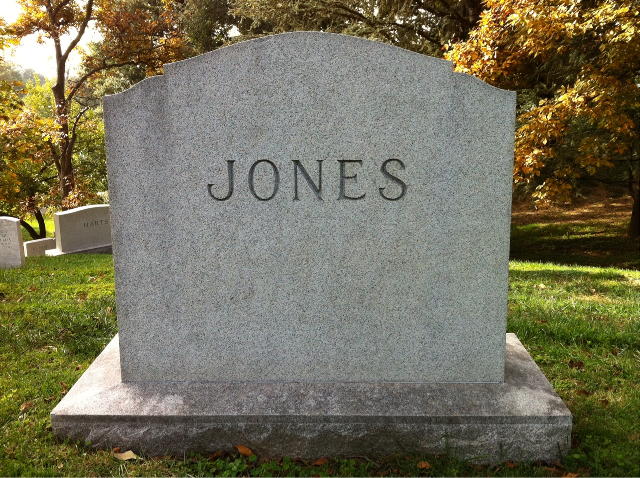
The grave monument for Frank B. Jones
Photo from the Arlington National Cemetery website
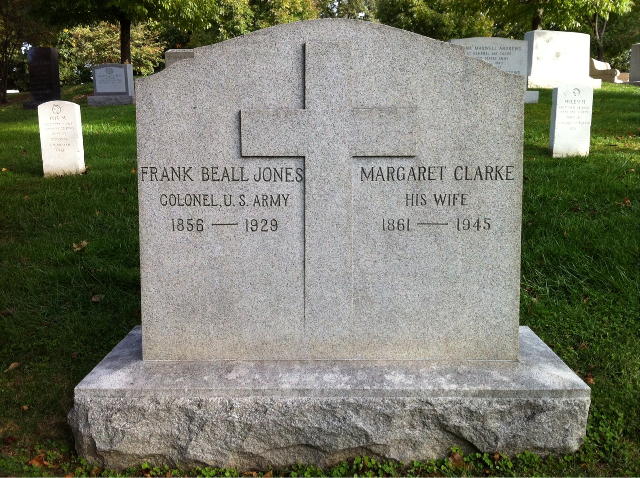
The grave monument for Frank B. Jones
Photo from the Arlington National Cemetery website
¹ SIXTY-FIRST ANNUAL REPORT of
the Association of Graduates of the United States Military
Academy
at West Point, New York June 11, 1930, The Moore Printing Company
Inc., Newburgh, N.Y.
Home | Photos | Battles & History | Current |
Rosters & Reports | Medal of Honor | Killed
in Action |
Personnel Locator | Commanders | Station
List | Campaigns |
Honors | Insignia & Memorabilia | 4-42
Artillery | Taps |
What's New | Editorial | Links |